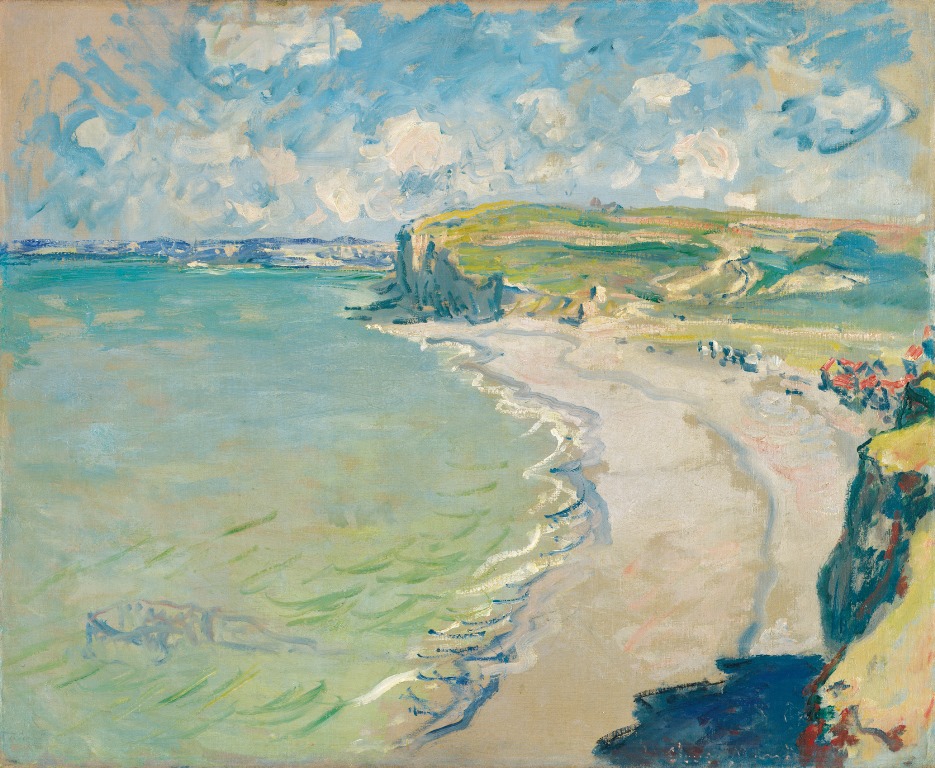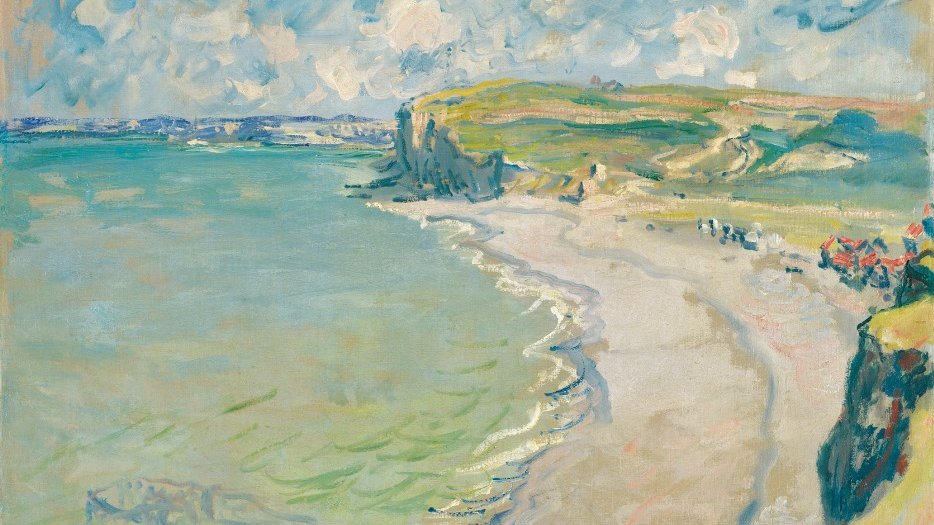How did "Beach in Pourville" get stolen?

The investigators assigned to the case believed that the painting was stolen by a very clever professional thief. Mercifully, nine years later, the perpetrator was caught and the painting recovered. Finding Beach in Pourville came as even more of a surprise than its theft.
Beach in Pourville is the most valuable painting in the holdings of the National Museum of Poznań and one of the most precious in Poland. This 60 x 73 cm oil-on-canvas work was painted in 1882. It forms part of the Pourville series, which also includes Fishing Nets at Pourville and Cliff Walk at Pourville.
In April 1906, the Kaiser Friedrich Museum of Poznań, which was then a German city, displayed a "traveling" collection of Impressionist works. The display featured works not only by Monet, but also by Pissarro, Sisley, Cezanne, Renoir and Degas. As was customary on such occasions, museums and collectors were allowed to purchase any painting of their choice. The German Society of Art bought Beach in Pourville for 7,000 marks and deposited it in the museum.
In 1918, after the victorious Wielkopolska Uprising, the painting remained in Poznań. In 1919, the museum's holdings were taken over by the newly established Wielkopolska Museum. The painting was displayed during the Interwar Period, but regrettably fell again into German hands during World War II. In 1943, the occupiers moved the most valuable pieces from Poznań for protection from a possible bombing. After a period of concealment in the cellars of the Międzyrzecz Fortified Region, the stash was shipped to Germany. Along with other works of art from Poznań, Monet's painting was discovered by Red Army troops in Saxony in May 1945.
The painting was then transferred to the Soviet Union where it ended up in the Hermitage Museum in Leningrad until it was moved again, this time to Moscow. After the war ended, Poland did its best to recover the works of art that fell into Soviets hands. The efforts succeeded in bringing parts of collections to Poznań and other parts of Poland in 1946. However, the most valuable painting, Beach in Pourville, was not among them. It was not until 1956 and the second phase of the recovery programme that the Soviets released the painting they had seized. To this day, many works of art from Polish collections remain in Russian museums. Talks about their return have ground to a halt a few years ago.
As for Beach in Pourville, the painting was on view in the Palace Museum of Rogalin from the 1970s to the early 1990s. Subsequently, the National Museum's management decided that a work of such value should be displayed in Poznań. Therefore, from 2001 onward, Poznań's Monet could be seen in its European painters section. And yet, admittedly, art connoisseurs were the only ones aware of its existence. The majority of museum visitors would pass by Claude Monet's masterpiece oblivious of its presence.
In fact, Poznań residents did not learn about the painting until Tuesday, September 19, 2000, the day it was stolen. A museum staff member noticed that Beach in Pourville protruded from its frame and that its colours had faded. As she inspected the painting more closely, her face turned just as pale. As it turned out, a copy had been inserted into the frame while the original was gone.
It was later determined that the theft had occurred two days earlier, on Sunday, 17 September. The thief had extra time to make himself scarce as the museum was closed on the following Monday. The prime suspect was a self-proclaimed "art student" who had spent several hours on Sunday in the room where the painting was displayed, apparently engaged in "drawing". However, rather than working on his sketches, the "student" was busy cutting Monet's painting out of its frame. What helped him was that the museum guard in charge of this part of the exhibition wore high heels. Her tapping gave the thief advance warning every time the woman approached. He would then cease cutting the canvas. The "student", who introduced himself as Jacek Walewski, had previously received permission to make a sketch from the museum director.
The robbery was pronounced "the heist of the century" and made headlines around the world. The loss was estimated at $7 million. The work of art was neither insured nor secured. The only traces the thief left behind were a few fingerprints. Based on the help of a forensic sketch artist and a handful of leads, it was presumed that that robbery had most likely been commissioned by a gang of art thieves. According to experts, there was little hope that the painting would ever be recovered.
A year on, the investigation was dropped after it hit a dead end. A PLN 100,000 award did nothing to produce further leads. However, due to the high value of the painting, the police were required to keep the case open. They would therefore talk to art thieves, art collectors and traders about Beach in Pourville, keep an eye on auction houses, check tips from informants and more. Finally, the latest technology combined with traditional investigative methods produced a break in the case.
In 2000, the Polish police acquired a new IT technology: an automated fingerprint identification system (AFIS). It enabled them to search through thousands of stored fingerprints against prints lifted from crime scenes. The problem was that as of 2000the prints of the "art student" who had stolen Beach in Pourville were not yet in the AFIS system.
They were added to the database in 2006 in connection with a completely different case of overdue alimony payment. Three years later, the persevering investigator, Junior Inspector Marek Pawlicki of the Forensic Laboratory of the Regional Police Headquarters in Poznań, found a match and established the suspect's name.
On 12 January 2010, police officers appeared at the residence of Robert Z., an unemployed bricklayer from Olkusz, who lived with his parents. After searching their home, they found Beach in Pourville hidden behind a closet wall, thankfully in good condition. The painting was immediately returned to Poznań where workers of the National Museum examined it with trembling hands and, in quivering voices, confirmed the painting's "authenticity".
In July 2010, after a one-day trial, the District Court of Poznań sentenced Robert Z. to three years in prison (without parole) and a fine of PLN 28,000 (to pay for the restoration and conservation). A mitigating circumstance was that the convict never intended to sell the painting: he stole it for his own viewing pleasure. As it turned out, Robert Z. had fallen in love with Beach in Pourville.
Szymon Mazur
translation: Krzysztof Kotkowski
© Wydawnictwo Miejskie Posnania 2020
See more

From One Celebration to Another

Christmas Markets and Fairs with Attractions

Truly Festive Vibes


